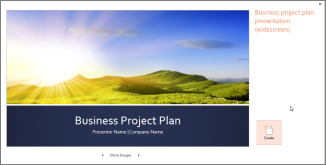Apply a template
In PowerPoint, click File, and then click New.
-
Do one of the following:
-
Type a key word or phrase into the Search for online templates and themes field, and press Enter.

Choose a template.
Tip: The template is downloaded to PowerPoint and you are ready to begin your presentation.
-
Click Featured, and choose a template to use.

-
Click Personal and pick a template that you've created.

-
-
When you find the template that you want, click it to see the details, and then click Create.

What is a PowerPoint template?
A PowerPoint template is a pattern or blueprint of a slide or group of slides that you save as a .potx file. Templates can contain layouts, colors, fonts, effects, background styles, and even content.
You can create your own custom templates and store them, reuse them, and share them with others. You can also find hundreds of different types of free templates on Office.com and on other partner websites that you can apply to your presentation.
Some examples of templates for Word, Excel, and PowerPoint on Office.com include, but are not limited to, the following:
Agendas |
Award certificates |
Brochures |
Budgets |
Business cards |
Calendars |
Content slides |
Contracts |
Databases |
Design slides |
Diagrams |
Envelopes |
Expense reports |
Fax sheets |
Flyers |
Forms |
Gift certificates |
Greeting cards |
Inventories |
Invitations |
Invoices |
Labels |
Letters |
Lists |
Memos |
Minutes |
Newsletters |
Plans |
Planners |
Postcards |
Purchase orders |
Receipts |
Reports |
Resumes |
Schedules |
Schedules |
Statements |
Stationary |
Time sheets |
A template can include the following:

1. Subject matter-specific content, such as Certificate of Achievement, Soccer
2. Background formatting, such as pictures, texture, gradient or solid fill color, and transparency. This example has a light-blue solid-fill background and the soccer ball image
3. Colors, fonts, effects (3-D, lines, fills, shadows, etc.), and theme design elements (such as the color and gradient effects inside the word Soccer)
4. Text in placeholders that prompt people to enter specific information. Examples in the picture above: Player's name, Name of coach, Date of presentation, and any variable, such as the year
Source: Microsoft
